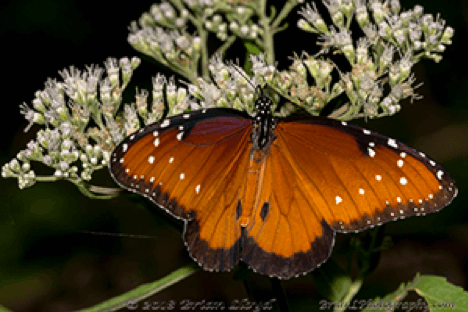Florida is home to almost 200 species of butterflies. Our warm climate and extended growing season make butterfly viewing a year-round activity. Located on two migratory pathways, top locations for observing several species of butterflies in Florida’s Capital region include St. Marks National Wildlife Refuge, Edward Ball Wakulla Springs State Park, the Apalachicola National Forest, Elinor Klapp-Phipps Park, Alfred B. Maclay Gardens State Park, Lake Elberta Park, as well as the L. Kirk Edwards Wildlife and Environmental Area. Explore our seasonal list of beautiful butterflies to watch for:
Spring
Butterfly numbers increase as plants bloom during spring. Redbud, plum, willow, dewberry, and thistle are early attractions. Later in the season, butterflies nectar on sparkleberry, blueberry, several milkweeds, butterfly pea, and more. Elinor Klapp-Phipps Park, Wakulla Springs State Park, the Bear Creek Educational Forest, and Angus K. Gholson Jr. Nature Park are among the many local sites where butterflies find such flowers.
Little Wood-Satyrs
Eastern Tiger Swallowtails
Some butterflies only fly in spring. Banded Hairstreaks are seen from late April through May; Little Wood-Satyrs usually from late March through
May. However, most species have a first brood in spring then additional broods later in the year. Pipevine Swallowtails and Eastern Tiger Swallowtails generally are out
by March. Some female Tigers have a dark gray background color, rather than yellow. They gain protection from predators by mimicking the toxic Pipevine Swallowtail, as do other dark swallowtails with blue on their hindwings.
Red Admiral
Zabulon Skippers
First-brood Red Admirals and Southern Dogfaces add more color to the season. The latter’s pale poodle head complete with a black eyespot, silhouetted against a darker background, is visible even through the closed wings. Territorial male Zabulon Skippers wait on leaves in patches of sunlight along forest trails to chase away rivals and to pursue any females that pass by.
Adult butterflies drink nectar from many different plants, but their caterpillars usually can eat the leaves or flowers of just a few kinds, sometimes only one. Other plants don’t provide the right nutrients, or the caterpillar can’t handle their physical and chemical defenses. After mating, female butterflies search for just the right plants on which to lay eggs. The caterpillars will then have a suitable food supply at their feet immediately after hatching.
When it comes to summer, butterflies don’t mind the heat and humidity. Golden Banded-Skippers, rare butterflies that are a specialty of Elinor Klapp-Phipps Park, seek shelter under leaves when it rains and take mid-day siestas under them when it doesn’t. They are found in wooded areas, often seen sipping nectar from large, yellow blooms such as bear’s foot. Red-spotted Purples are found in wooded areas too, but seldom visit flowers. They often are seen on bare ground, especially after rains. They are excellent mimics of Pipevine Swallowtails (see the spring article); in some ways better mimics than other swallowtails. Red-spotted Purples, despite looking very different, are close relatives of, which mimic Monarchs. Viceroy caterpillars eat willow leaves, so this butterfly is most common in wet areas such as Black Swamp Nature Preserve. Both species also can be found at the Ochlocknee River Wildlife Management Area.
Golden Banded-Skipper
Red-spotted Purples
Viceroy
Other butterflies prefer sunnier, more open habitats. The white, spherical blooms of buttonbush, at ponds in the Munson Hills area of the Apalachicola National Forest just south of Tallahassee, attract many butterflies in early summer. Zebra Swallowtails are conspicuous visitors. Their caterpillars eat the leaves and flowers of pawpaws growing the area’s sandy soil. Southern Cloudywings also visit buttonbush, as do its two close relatives, Northern Cloudywing and Confused Cloudywing. The latter is intermediate in appearance between Northerns and Southerns and can be confused with either of them, hence the name.
Zebra Swallowtails
Fiery Skippers
Barred Yellows
Gray Hairstreaks
Bright orange Fiery Skippers, with dark dots on the underside of their hindwings, are seen at all of the sites mentioned so far. In fact, these small butterflies can be found in almost any grassy place with wildflowers throughout the area are found in a wide variety of open habitats too. They are particularly common at Munson Hills and the Blue Springs Wildlife Management Area. They are most likely to be seen just flying by but do sometimes stop at flowers. In summer, the undersides of their hindwings are white and appear to be sprinkled with pepper. However, from fall to early spring the background color of the hindwings is rusty brown to match the hues of dead leaves. Gray Hairstreaks also are common in many open sunny places, including gardens, usually on a plant’s highest bloom. They are common at Blue Springs WMA in summer and often are seen atop southern rattlesnake master. Unlike most hairstreaks, Gray’s open their wings to bask fairly often.
Some good butterfly sites in the region experience an early- to mid-summer slump. Many species have two broods per year, the first in spring and the second in late summer or fall, with a gap in between. The adults of those species often aren’t around in June or July. Things start to pick up again in August. The sites mentioned above, however, all have good numbers of butterflies throughout the summer months. For some of them summer is the best time!
Fall / Winter
American Ladies and Common Buckeyes, both with multi-colored eyespots, often can be found in the Tallahassee area during the winter. Small, orange-and-black Pearl Crescents are frequently seen too. Florida’s state butterfly, Zebra Heliconian, black with narrow yellow stripes, may fly all through mild winters, but usually disappears after hard freezes. Large, yellow Cloudless Sulphurs and somewhat smaller Sleepy Oranges often get minerals from damp ground. Elinor Klapp-Phipps Park, Lafayette Heritage Trail Park, and Black Swamp Nature Preserve are good places to look for them.
These are just a few of the more than two dozen butterflies that can be seen in the Tallahassee area December-February. Most are seen before the first hard freeze or after the last one, but some can be found on warm, sunny afternoons, even in January. Most butterflies drink nectar from flowers, so a good way to find them during the cold months is to look for patches that are exposed to the sun, but sheltered from the wind. Spanish needles (Bidens alba), with white petals and a yellow center, is a favorite native nectar source.
Mourning Cloaks are seen regularly at Torreya State Park, located 40 miles west of Tallahassee, and irregularly at Elinor Klapp-Phipps Park in town. They are famous for flying on mild winter days, even farther north, but, unlike most butterflies, don’t drink flower nectar.
In the winter, coastal sites usually have higher nighttime temperatures than inland sites and therefore may have more butterflies. At St. Marks National Wildlife Refuge and the Big Bend Wildlife Management Area keep an eye out for Queens, and their close relatives Monarchs (they don’t all migrate to Mexico).
American Lady
Common Buckeye
Cloudless Sulphurs
Zebra Heliconian
Pearl Crescent
Mourning Cloak
Queen
Monarch
Author:
David Harder
North American Butterfly Association



